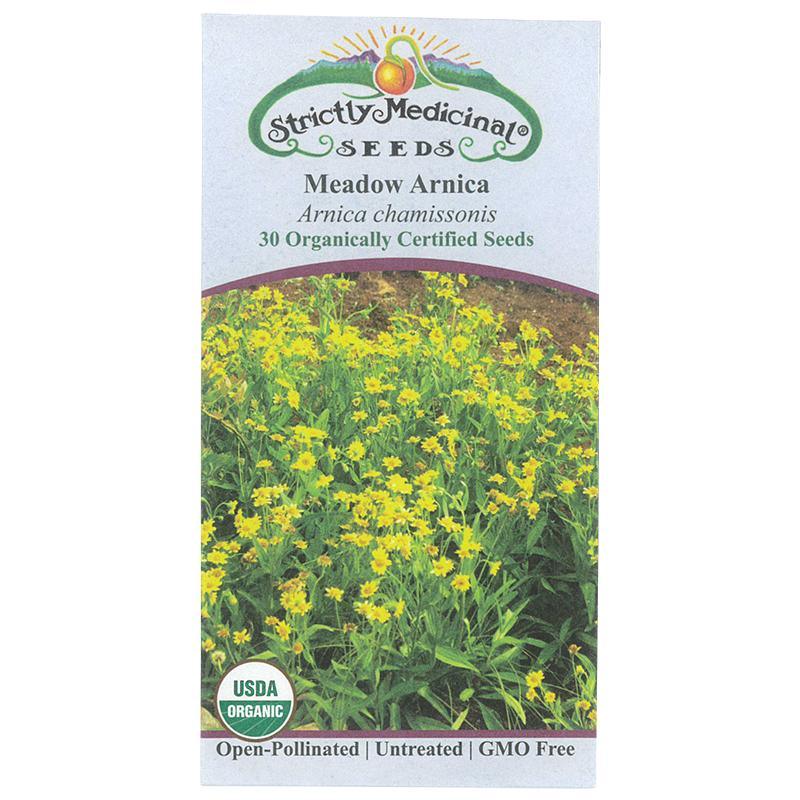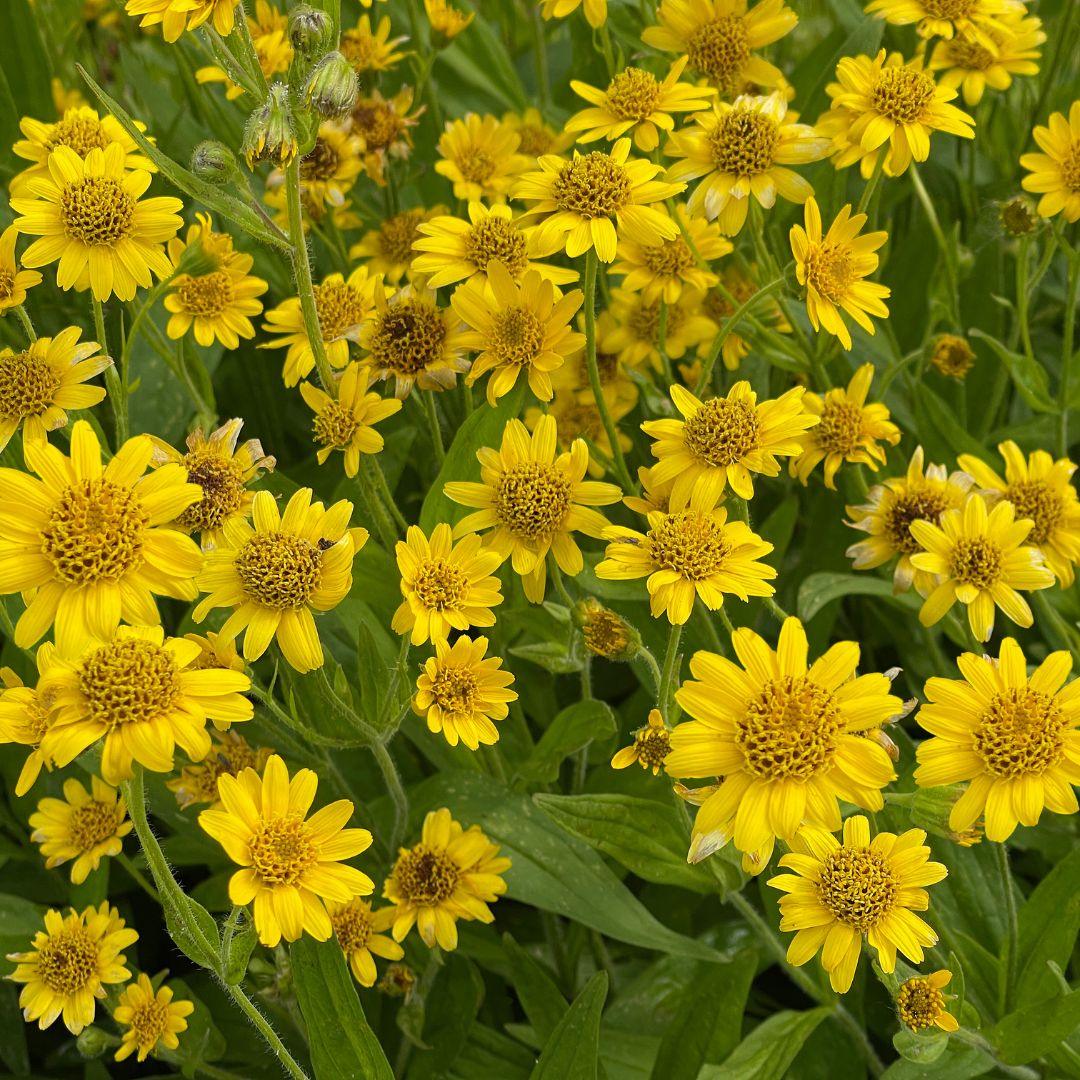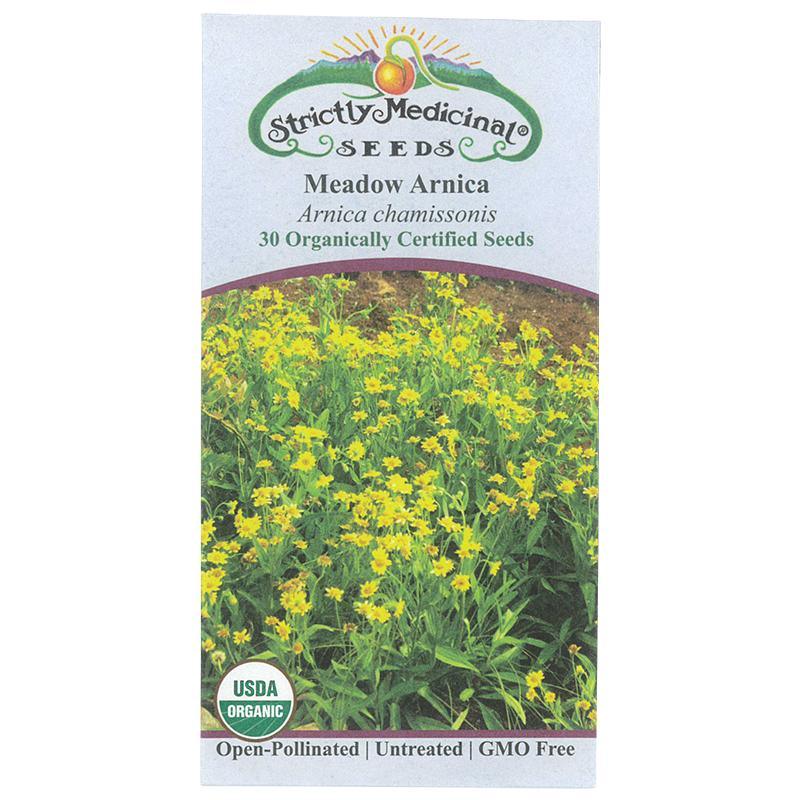Item Number: SNV7002
Meadow Arnica Seeds (Organic)
Popular Member of the Daisy Family
Meadow Arnica is a treasured perennial herb known for its bright yellow, daisy-like flowers and long-standing reputation in herbal medicine. This hardy plant is a standout in gardens, providing both aesthetic charm and practical benefits. Meadow Arnica thrives in cool, well-draining soil and prefers full sun to partial shade, making it adaptable to various growing conditions. The flowers, often harvested for their natural healing properties, are commonly used in salves, tinctures, and poultices to soothe bruises, sprains, and sore muscles. Arnica seeds are easy to plant, germinating within 14-21 days, and mature plants reach a height of 12-24 inches, adding vibrant color to any landscape. Perfect for pollinator-friendly gardens, meadow arnica attracts bees and butterflies, promoting biodiversity. Its low-maintenance nature makes it ideal for both novice and experienced gardeners alike. Whether you’re cultivating it for its medicinal uses or as a stunning addition to your garden, meadow arnica delivers beauty and functionality. With its deep roots in traditional remedies and ecological benefits, arnica is an essential plant for those seeking to blend natural wellness with sustainable gardening practices. Add meadow arnica to your garden, and enjoy a plant that is as versatile as it is beautiful.
Meadow Arnica - Arnica chamissonis
Perennial Herb. Heirloom. Meadow Arnica is a medicinal herb cherished for its vibrant yellow, daisy-like blooms and its natural healing properties. This robust perennial thrives in meadows and gardens with cool, moist climates. Renowned for its use in traditional herbal medicine, arnica is especially valued for treating bruises, sprains, and muscle pain.
Did You Know? Meadow Arnica is an eco-friendly addition to pollinator gardens, attracting bees and butterflies while also serving as a sustainable source for homeopathic remedies.
- Soil Temperature: 60-70°F
- Planting Depth: 1/8"-1/4"
- Germination: 14-21 Days
- Height At Maturity: 12"-24"
- Days To Maturity: 90-120 Days
- Sun/Shade: Full Sun to Partial Shade
- Spacing After Thinning: 6"-12"
- Approx Seeds per Pack: 100 Seeds
Arnica meadow seeds offer a unique and ecologically beneficial addition to your garden or landscape. These seeds, sourced from the Arnica montana plant, provide a vibrant and diverse habitat that attracts a multitude of beneficial insects.
Arnica Meadow Seeds Basics
Arnica montana, commonly known as mountain arnica or simply arnica, is a European flowering plant celebrated for its medicinal properties. Arnica meadows, planted with Arnica montana seeds, are cultivated not only for their beauty but also for their role in supporting biodiversity. These meadows serve as valuable habitats for beneficial insects, including pollinators and predators.
Key Features of Arnica Meadow Seeds:
Beneficial Insect Attraction: Arnica meadows are a haven for beneficial insects such as bees, butterflies, ladybugs, and predatory insects. These insects play crucial roles in pollination and natural pest control, contributing to healthier and more productive gardens.
Native Wildflowers: Arnica meadows feature an array of native wildflowers, including Arnica montana, that are well-suited to local ecosystems. Native plants are adapted to the region's climate and support native insect populations.
Natural Beauty: Beyond their ecological significance, Arnica meadows are visually stunning. The diverse mix of wildflowers creates a vibrant and colorful landscape, making them an attractive addition to any garden or landscape design.
Low Maintenance: Once established, Arnica meadows require minimal maintenance. Native plants are well-adapted to local conditions and generally thrive with little intervention.
Medicinal Value: Arnica montana, the primary plant in Arnica meadows, is known for its medicinal properties. Its flowers have been used in traditional remedies to soothe skin irritations and reduce inflammation. However, it's essential to note that Arnica should be used with caution and in accordance with medical guidance.
How to Grow Arnica Meadow Seeds:
Site Selection: Choose a sunny location for your Arnica meadow, as most wildflowers thrive in full sun. Ensure that the site has well-draining soil.
Seed Preparation: Before sowing Arnica meadow seeds, it's advisable to prepare the soil. Remove any weeds, rocks, or debris from the area. You can also lightly till the soil to create a suitable seedbed.
Sowing: Scatter the Arnica montana seeds evenly over the prepared soil. Lightly tamp down the seeds to ensure good soil-to-seed contact.
Watering: Water the newly sown seeds gently to moisten the soil. Avoid overwatering, as excessive moisture can lead to rot.
Maintenance: Once the Arnica meadow is established, it typically requires minimal maintenance. Regular watering may be necessary during dry spells, but native plants are generally adapted to local rainfall patterns.
Enjoy: Watch as your Arnica meadow springs to life with a profusion of native wildflowers. Be patient, as it may take some time for the meadow to reach its full potential and attract a diverse array of beneficial insects.
Benefits of Arnica Meadows:
Pollinator Support: Arnica meadows provide nectar and pollen for bees and butterflies, enhancing pollination in your garden.
Natural Pest Control: Predatory insects, attracted by the diverse plant species in Arnica meadows, help control garden pests naturally, reducing the need for chemical pesticides.
Biodiversity: By creating habitats for beneficial insects and native plant species, Arnica meadows contribute to biodiversity and the overall health of ecosystems.
Aesthetic Appeal: The vibrant display of native wildflowers in Arnica meadows adds beauty and visual interest to your garden or landscape.
Low Environmental Impact: Arnica meadows promote sustainable and environmentally friendly gardening practices by reducing the reliance on chemical inputs.
Arnica meadow seeds offer a win-win solution for gardeners and the environment. Not only do they create a visually appealing and low-maintenance landscape, but they also play a vital role in supporting beneficial insects, native plant species, and overall biodiversity. By incorporating Arnica meadows into your garden or landscape, you can enjoy the beauty of nature while contributing to a healthier and more sustainable ecosystem.
These are not health claims; see a medical professional for information on medicinal benefits and risks.




Check Your Zone Compatibility:
Compatible with your zone.
Growing Zone for

Our Guarantee To You
Since 1976, we've served our customers at every stage of growing. Please contact us at any time. We are happy to support and assist you.
Shipping Information
Shipping Information
Shipping Weight: 0.01 lb
Dimensions: 5.0"L x 2.625"W x 0.1"H
Features
Features
- Container Compatible
- Good for Drying
- Open-Pollinated
- Plant Spreads
- Requires Summer Water
- Suited to Warmer Climates
Characteristics
Characteristics
Planting & Care
Planting & Care
Soil & Water:Grows in wide range of soils, but prefers acidic, loamy conditions in full to partial shade. Soil should remain moist, but never saturated. Does not tolerate drought conditions.
Planting & Growing: Plant in loose soil of raised beds or in containers or flats. Barely cover seed with soil and tamp securely. Keep evenly moist and warm with a light source until germination which usually takes 1-3 weeks. Transplant to 1 foot apart.
Harvesting & Storage: Harvest flowers for drying in late summer and roots in the fall.
Useful Information
Useful Information
Guarantee
Guarantee
Share






